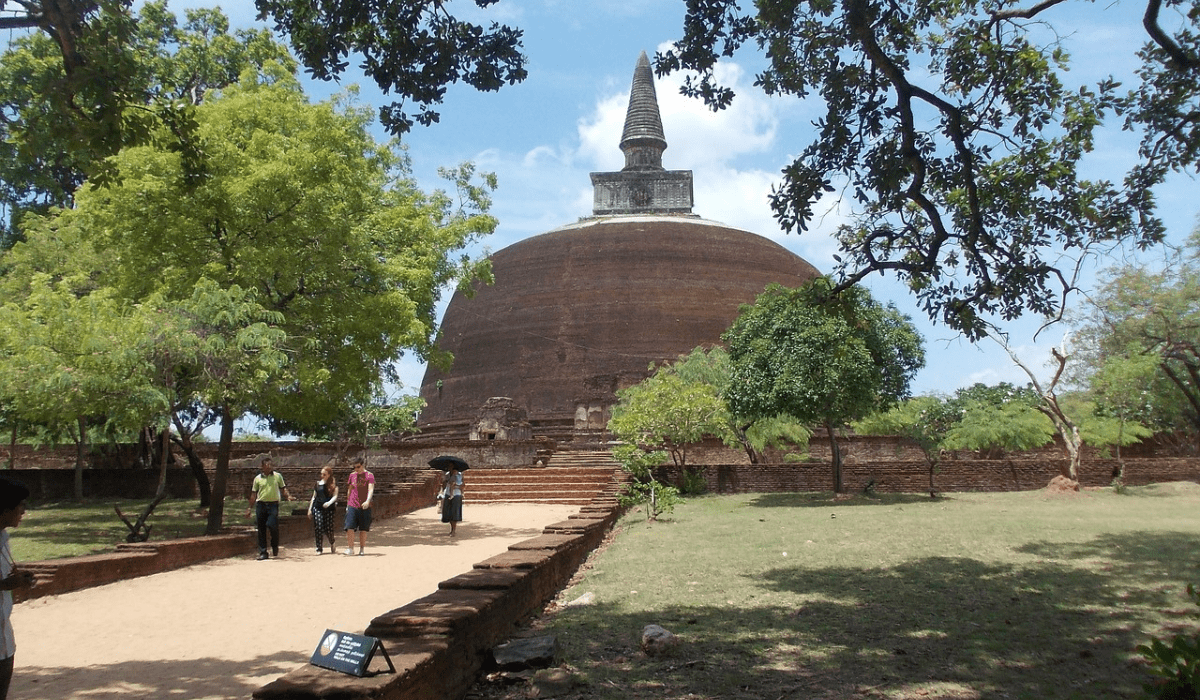Abayagiriya was not only a place of worship but also a renowned center for Buddhist scholarship. The monastery housed a vast library and attracted eminent scholars who contributed to the dissemination and preservation of Buddhist teachings.
Introduction
Table of Contents
Sri Lanka, an island rich in history and culture, is home to numerous ancient Buddhist temples that offer both spiritual solace and a glimpse into the island’s storied past. Among these revered sites, Abayagiriya stands out as a significant Buddhist temple and an attractive tourist destination in Anuradhapura, Sri Lanka. This article delves into the history of Abayagiriya, its cultural significance, traditional practices, and other captivating aspects that make it a must-visit spot for those seeking spiritual and cultural enrichment. The focus keyword for this article is “Abayagiriya.”

Abayagiriya Stupa – Anuradhapura , Sri Lanka
History of Abayagiriya
The Founding of Abayagiriya
Abayagiriya, also known as Abhayagiri Vihāra, was established in the 2nd century BCE by King Valagamba (also known as King Vattagamini Abhaya) after he reclaimed his throne following a period of exile. The temple was built as a gesture of gratitude to a Buddhist monk who provided him shelter during his time of hiding from South Indian invaders. This act of devotion laid the foundation for what would become one of the most significant monastic complexes in ancient Sri Lanka.
The Development of the Monastery
Under the patronage of various kings and benefactors, Abayagiriya grew to become one of the largest and most influential monasteries in the region. It served as a major center for Buddhist learning, attracting scholars, monks, and pilgrims from across the Buddhist world. The monastery’s development included the construction of numerous stupas, shrines, and other architectural marvels, making it a focal point of religious and cultural activity in ancient Anuradhapura.
Cultural Significance of Abayagiriya
A Center for Buddhist Scholarship
Abayagiriya was not only a place of worship but also a renowned center for Buddhist scholarship. The monastery housed a vast library and attracted eminent scholars who contributed to the dissemination and preservation of Buddhist teachings. It became a hub for intellectual exchange, where monks engaged in debates, studied scriptures, and produced important commentaries on Buddhist texts. This scholarly tradition contributed to the spread of Theravada Buddhism throughout the region.
Promoting Buddhist Practice
The monastery played a crucial role in promoting Buddhist practice among the local population. It served as a spiritual refuge for monks and laypeople alike, offering a space for meditation, prayer, and the observance of religious ceremonies. Abayagiriya’s influence extended beyond its immediate surroundings, shaping the spiritual lives of countless individuals and fostering a deep sense of devotion to the Buddha’s teachings.
Traditional Practices and Activities
Meditation and Mindfulness
At the heart of Abayagiriya’s spiritual offerings was its emphasis on meditation and mindfulness. The monastery provided a conducive environment for monks and lay practitioners to cultivate inner peace and clarity through meditation. The tranquil surroundings and serene atmosphere made it an ideal retreat for those seeking to deepen their meditation practice and attain higher states of consciousness.
Rituals and Ceremonies
Abayagiriya was a site of numerous religious rituals and ceremonies, many of which continue to be observed to this day. Key among these is the full moon day (Poya) observance, during which devotees gather to participate in rituals, offer alms to monks, and listen to Dhamma sermons. These ceremonies provide an opportunity for the community to come together in collective worship and reaffirm their commitment to Buddhist principles.
Architectural Marvels of Abayagiriya
The Abayagiriya Stupa
One of the most striking features of Abayagiriya is its majestic stupa, which stands as a testament to the architectural prowess of ancient Sri Lankan builders. The Abayagiriya Stupa, originally constructed to a height of 100 meters, was one of the tallest structures of its time. Although it has undergone several restorations over the centuries, the stupa retains its grandeur and continues to be a focal point of veneration for pilgrims.
Other Significant Structures
In addition to the main stupa, the Abayagiriya complex includes a variety of other significant structures, such as the Uposathagara (Chapter House), which was used for monastic meetings and the recitation of the Patimokkha (monastic code). The monastery also features numerous smaller stupas, image houses, and meditation halls, each reflecting the rich architectural heritage of ancient Sri Lanka.
The Influence of Abayagiriya on Buddhism
A Hub for Theravada Buddhism
Abayagiriya played a pivotal role in the propagation of Theravada Buddhism, not only in Sri Lanka but also across Southeast Asia. The monastery’s scholars and monks were instrumental in the dissemination of Buddhist teachings, establishing a network of monastic centers that facilitated the spread of the Dhamma. This influence is evident in the shared cultural and religious practices that continue to bind Buddhist communities in the region.
The Legacy of Abayagiriya
The legacy of Abayagiriya extends beyond its historical significance. The monastery’s contributions to Buddhist scholarship, religious practice, and cultural heritage have left an indelible mark on the spiritual landscape of Sri Lanka. Today, Abayagiriya stands as a symbol of the enduring strength and resilience of Buddhism, inspiring generations of practitioners to uphold the values of compassion, wisdom, and mindfulness.
Encouraging Global Tourism
A Destination for Spiritual Tourism
Abayagiriya has emerged as a premier destination for spiritual tourism, attracting visitors from all corners of the globe. The monastery’s serene ambiance, coupled with its rich history and cultural significance, makes it a compelling choice for those seeking a spiritual retreat. Tourists are drawn to Abayagiriya not only for its religious significance but also for the opportunity to explore the ancient ruins and immerse themselves in the tranquil beauty of the site.
Promoting Sri Lanka’s Heritage
By attracting international tourists, Abayagiriya plays a vital role in promoting Sri Lanka’s cultural and spiritual heritage on a global stage. The temple’s emphasis on sustainable tourism and environmental conservation aligns with the broader goals of responsible tourism, ensuring that visitors can enjoy and appreciate Sri Lanka’s natural beauty and cultural richness while minimizing their impact on the environment.
Practical Information for Visitors
Getting to Abayagiriya
Abayagiriya is located in Anuradhapura, one of Sri Lanka’s ancient capitals and a UNESCO World Heritage Site. The site is easily accessible by road, with regular bus and train services connecting Anuradhapura to major cities such as Colombo and Kandy. Visitors can also hire private transport or join guided tours to explore the monastery and its surroundings.
Best Time to Visit
The best time to visit Abayagiriya is during the dry season, which runs from May to September. During this period, the weather is generally pleasant, making it ideal for exploring the outdoor ruins and participating in religious activities. However, visitors should be prepared for occasional rainfall and bring appropriate clothing and gear.
Visitor Guidelines
When visiting Abayagiriya, it is important to observe the following guidelines to ensure a respectful and enjoyable experience:
- Dress modestly and cover your shoulders and knees, as a sign of respect for the religious site.
- Remove your shoes and hats before entering sacred areas, such as the stupa and image houses.
- Refrain from loud conversations and disruptive behavior, to maintain the serene atmosphere of the monastery.
- Dispose of trash responsibly and avoid littering, to preserve the cleanliness and beauty of the site.
Conclusion
Abayagiriya is more than just a historical monument; it is a living testament to the enduring legacy of Buddhism in Sri Lanka. With its rich history, cultural significance, and serene surroundings, Abayagiriya offers a unique and enriching experience for visitors seeking spiritual growth and cultural immersion. As a beacon of peace and unity, the monastery continues to inspire and uplift individuals from all walks of life, making it a must-visit destination for anyone exploring the spiritual and cultural treasures of Sri Lanka.
For those planning a trip to Sri Lanka, a visit to Abayagiriya promises to be a transformative journey that offers profound insights into the Buddhist way of life and the timeless beauty of this enchanting island nation.





One thought on “Abayagiriya: A Timeless Buddhist Sanctuary in Anuradhapura, Sri Lanka.”
Comments are closed.